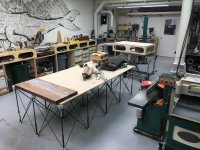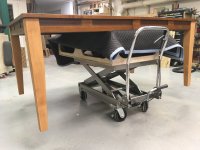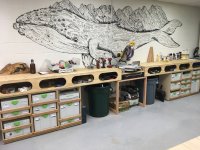Stan Tillinghast
Member
- Joined
- Mar 18, 2007
- Messages
- 309
I’m sure many of you have problems with low back pain, it’s almost universal to some degree as we get older. I have lumbar spinal stenosis and also arthritis in the lower spine; my symptoms are just low back pain, not sciatica or other neurological symptoms. Clearly made worse by lifting and twisting.
After years of moving around when I couldn’t have a decent shop, I am setting up a workshop in part of our 3-car garage (space can vary from 1 to 3 bays if needed). I’m planning first to build cabinets for the workshop, then for the house: bookcases, storage cabinets, eventually maybe bathroom and kitchen cabinets.
I got into the Festool addiction years ago before the back problems showed up; but it turns out that using the track saw as opposed to moving sheet goods around a table saw; and other aspects of Festool operations seem to me to be as good a way as any of doing woodworking with back pain.
My question for those of you who have been dealing with this is: do you have any specific tips or recommendations in terms of work flow, storage, specific tools, specific “must-not-do” actions that you have found important?
For example, I’m contemplating ordering an STM 1800 to make it easier to move sheet goods from vehicle to workshop then ripping on the table. If it makes it possible to continue to do woodworking, then the expense is really secondary. One thing I like is the adjustable work height; it’s not clear what is the optimal height for me but I think given adjustability I could work that out.
Perhaps this has already been hashed out in other threads, or perhaps YouTube videos; if so please post a link.
I’ve found advice here on FOG very valuable if expensive. Thanks in advance for your help.
After years of moving around when I couldn’t have a decent shop, I am setting up a workshop in part of our 3-car garage (space can vary from 1 to 3 bays if needed). I’m planning first to build cabinets for the workshop, then for the house: bookcases, storage cabinets, eventually maybe bathroom and kitchen cabinets.
I got into the Festool addiction years ago before the back problems showed up; but it turns out that using the track saw as opposed to moving sheet goods around a table saw; and other aspects of Festool operations seem to me to be as good a way as any of doing woodworking with back pain.
My question for those of you who have been dealing with this is: do you have any specific tips or recommendations in terms of work flow, storage, specific tools, specific “must-not-do” actions that you have found important?
For example, I’m contemplating ordering an STM 1800 to make it easier to move sheet goods from vehicle to workshop then ripping on the table. If it makes it possible to continue to do woodworking, then the expense is really secondary. One thing I like is the adjustable work height; it’s not clear what is the optimal height for me but I think given adjustability I could work that out.
Perhaps this has already been hashed out in other threads, or perhaps YouTube videos; if so please post a link.
I’ve found advice here on FOG very valuable if expensive. Thanks in advance for your help.



